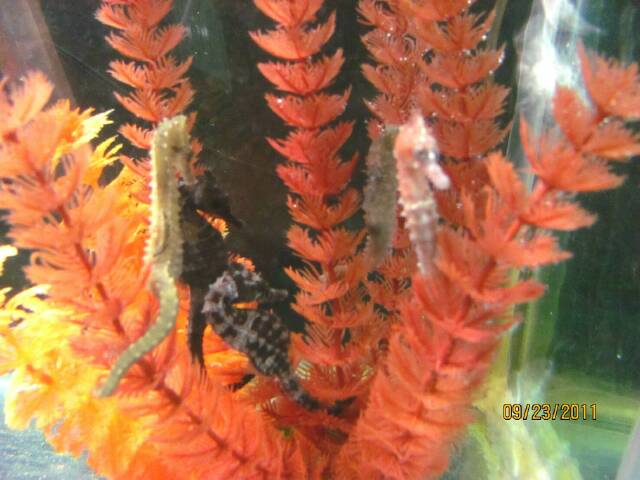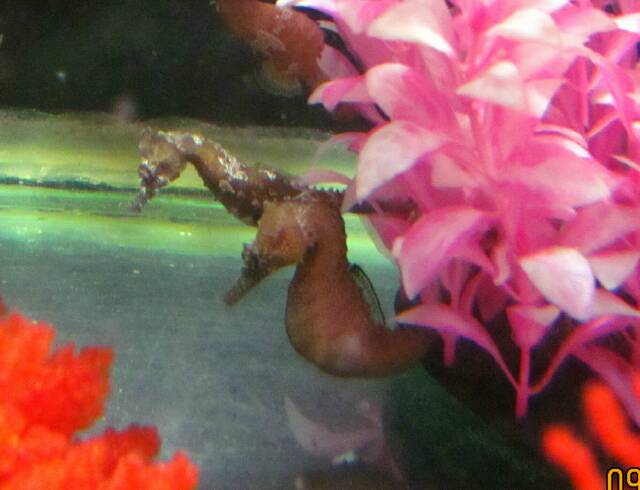You are using an out of date browser. It may not display this or other websites correctly.
You should upgrade or use an alternative browser.
You should upgrade or use an alternative browser.
How true is it ......
- Thread starter TandN
- Start date
The biggest problem is trying to influence the colour you want. I've tried making them go red by placing red decor and painting the bottom, ends, and back of the tank red and still that didn't work.
What I've had most success with in keeping the colour they had when they were purchased is to paint the bottom etc...... sky blue instead of the red, and they have maintained some of the colours but others still changed to yellow/beige or black/brown.
I just imported a lot of H. erectus and they came in basic black/brown to light beige, some showing white/grey bands, but in the non painted tank with red/pinkish decor they have a little bit of colour now after just 2 weeks since I picked them up at the airport.



What I've had most success with in keeping the colour they had when they were purchased is to paint the bottom etc...... sky blue instead of the red, and they have maintained some of the colours but others still changed to yellow/beige or black/brown.
I just imported a lot of H. erectus and they came in basic black/brown to light beige, some showing white/grey bands, but in the non painted tank with red/pinkish decor they have a little bit of colour now after just 2 weeks since I picked them up at the airport.



Cantgrowdidly
New member
My Kellogi were solid black when I got them, they live in cullepera and are now mostly yellowish green with bars.
pledosophy
Active member
I know I am an exception, but none of my seahorses have ever changed color from the time of purchase to the time of death. Remained the same through many tanks. One seahorse was in 5 or 6 different tanks and was always the same color.
JME
JME
pledosophy
Active member
They typically change color to match there environment. Put up a red backround with red chains for hitches you'll have red horses. Same with Yellow.
Just never been into that myself.
Just never been into that myself.
Allmost
New member
I know I am an exception, but none of my seahorses have ever changed color from the time of purchase to the time of death. Remained the same through many tanks. One seahorse was in 5 or 6 different tanks and was always the same color.
JME
They typically change color to match there environment. Put up a red backround with red chains for hitches you'll have red horses. Same with Yellow.
Just never been into that myself.
why did they die ? nutrition deficiencies ? that's why they never changed color.
as Ray stated above, your second statement is incorrect ...
Allmost
New member
The biggest problem is trying to influence the colour you want. I've tried making them go red by placing red decor and painting the bottom, ends, and back of the tank red and still that didn't work.
What I've had most success with in keeping the colour they had when they were purchased is to paint the bottom etc...... sky blue instead of the red, and they have maintained some of the colours but others still changed to yellow/beige or black/brown.
I just imported a lot of H. erectus and they came in basic black/brown to light beige, some showing white/grey bands, but in the non painted tank with red/pinkish decor they have a little bit of colour now after just 2 weeks since I picked them up at the airport.



Ahhh !Ray, so those were your seahorses ??!!! I think I got a couple form the same batch
I was too late and could only pick up 4 males ... but they are all yellow now
you already know why I "think" seahorses change color .. higher/normal temp, which in turn means more food intake, higher methabolism and ... of course I can be wrong. what temp do you keep yours at ?
They typically change color to match there environment. Put up a red backround with red chains for hitches you'll have red horses. Same with Yellow.
Just never been into that myself.
Tried that with my tank painted on the bare bottom panel, back and ends with red and orange hitching and they lost their red and orange colour and became dark brown/black and tan/yellows.
Same horses now in tank with sky blue paint on all glass except front panel, and same coloured hitches, some have regained SOME of their colour.
If you picked up some of the erectus shipment then you most likely got females as there was about 2 1/2 times as many females as males there.
As for tank temperatures, I started with temperatures of 80° back some years ago when I got started, but no colours were ever evident.
After having many problems with survival, I went to the suggested temperature range on the org of 68° to 74° by taking out my heaters and letting the tanks sit at the room temperatures running 69° to 73°.
With my reidi that are showing some colour now, I boosted the temperature to 78° for 18 weeks and there was no difference in them at that point.
I did end up with tail rot on one of the seahorses though. Fortunately after treatment she is OK now.
As for tank temperatures, I started with temperatures of 80° back some years ago when I got started, but no colours were ever evident.
After having many problems with survival, I went to the suggested temperature range on the org of 68° to 74° by taking out my heaters and letting the tanks sit at the room temperatures running 69° to 73°.
With my reidi that are showing some colour now, I boosted the temperature to 78° for 18 weeks and there was no difference in them at that point.
I did end up with tail rot on one of the seahorses though. Fortunately after treatment she is OK now.
so rayjay your saying background yet temparture changes the background. I am planing a SH tank in the furute maybe 6 months I have 3 friends that have had theres for 5+ years in there reef tanks with tunzes in them and there ll doing great any of you guys have success with this ? Im waiting to finish m research before i get them I dont like buying things to have them die due to lack of knowledge
Temperature hasn't made any difference in the background I painted on my tanks.so rayjay your saying background yet temparture changes the background.
Being successful in a reef tank you need to ask them what the secret is.I am planing a SH tank in the furute maybe 6 months I have 3 friends that have had theres for 5+ years in there reef tanks with tunzes in them and there ll doing great
I know of many who tried and failed, me included.
Allmost
New member
so rayjay your saying background yet temparture changes the background. I am planing a SH tank in the furute maybe 6 months I have 3 friends that have had theres for 5+ years in there reef tanks with tunzes in them and there ll doing great any of you guys have success with this ? Im waiting to finish m research before i get them I dont like buying things to have them die due to lack of knowledge
what kind of tunze and what corals ?
Ive had reidis for past 2.5 years in a soft coral tank, connected to a SPS tank, with 2xmaxijet 1200 power heads [30G is the tank size] with no ISsues ...
but I feed in a bowl, and remove uneaten food religiously ...
Allmost
New member
its a 60g mix tank with 2 tunze 6055's on low
well it cannot be mixed reef
SPS need more flow ..
so it is a soft coral tank
